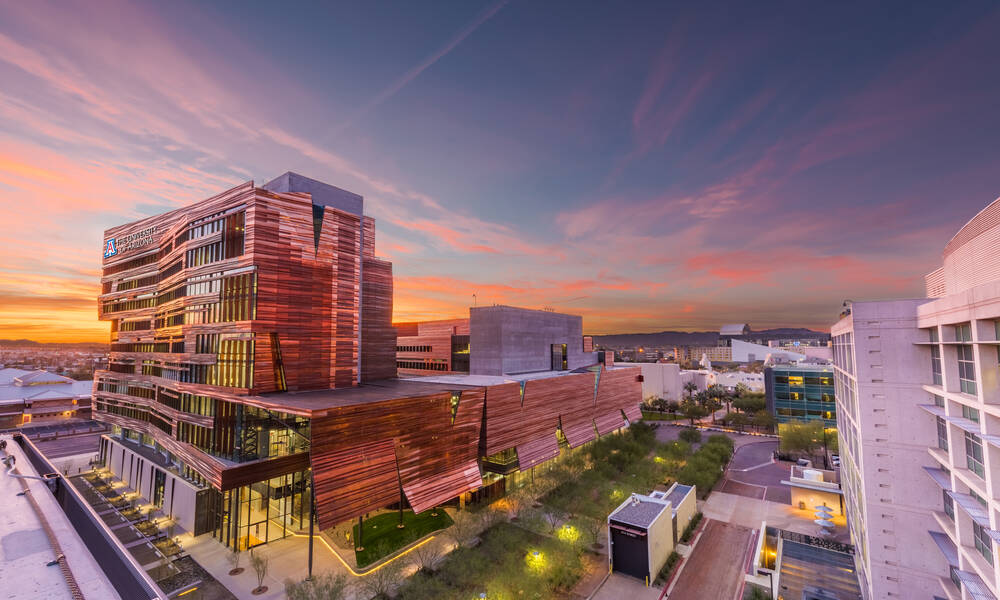
The Future of Meetings: Find Out How Specialized Cities Lend Themselves To Specialized Meetings
Given the challenges of face-to-face gatherings, destinations must provide an ideal learning environment that justifies the travel.
As if selecting a host city for a meeting or convention ever came down to simply looking at locations with the best hotels and the largest convention center, the pandemic changed the calculus. Now that people only convene with great purpose and care, meeting professionals will—more than ever—examine whether or not a city has the resources, speakers and facilities to provide the best learning environment to justify the facetime.
When it comes to medical and science-focused meetings, the Phoenix Biomedical Campus (PBC)—a 30-acre urban medical and bioscience campus offering more than 6 million square feet of academic and clinical space in downtown Phoenix—serves as a natural extension of the learning environment provided by the Phoenix Convention Center, located less than a half mile away.
The city-owned campus, which was established in 2004, now encompasses more than a dozen research facilities, including TGEN, home to the International Genomics Consortium and the National Institute of Diabetes and Digestive and Kidney Diseases; the Arizona Biomedical Collaborative, a $31-million research facility shared by Arizona State University and the University of Arizona; various medical programs and specialities; research, academic, and clinical facilities. The PBC also contains the highest concentration of research scientists and complementary research professionals in the region, providing firms with unprecedented opportunities for growth and collaborative efforts with industry leaders.
In August, David Krietor became the PBC’s first-ever executive director. The former president and chief executive officer of Downtown Phoenix Inc. will partner with the city to attract businesses well-matched to the universities’ work. And he’s devoted to the ongoing growth and success of the campus.
Indeed, the campus continues to grow explosively: This fall, look for the opening of a gleaming new $77 million research and office building developed by Wexford Science + Technology. The 225,000-square-foot project will house the first training and certification center for Arizona’s biosciences industry. It will also lease 104,000 square feet of lab space for biomedical companies and other research.
The Health Sciences Education Building (pictured above) is home to a simulation and innovation center, an anatomy lab, lecture halls, clinical education suites, and various flexible classrooms, which meeting planners can use for training and certification purposes, says Allison Otu, executive director of corporate & community relations for The University of Arizona Health Sciences.
One group that has recently taken advantage of the Center for Simulation and Innovation was able to provide training and certification for members during an annual meeting. The center—which includes an operating room, control room, and briefing rooms, and the Arizona Telemedicine Center, which boasts an amphitheater with HD videoconferencing capabilities—offers space to stage a variety of sessions and workshops for up to 125 attendees at once.
“It’s difficult to organize something like this in a facility with patients, because it’s too disruptive,” Otu says. The PBC provides the staff and equipment for the training. “Meeting planners are able to leverage the expertise of the staff and align their expertise to the objectives of their meeting,” she says.
The PBC allows conference attendees to easily move between the two sites to maximize resources and scheduling. The proximity of the PBC also enables staff to easily serve as keynote and panel speakers at conventions. There are more than 200 full-time faculty members at the PBC who are available to bring their expertise to general medical sessions as well as specific research areas, such as traumatic brain injury, stroke and neurology, Otu says.
In November 2019, the PBC hosted 5,000 attendees from a medical association. In addition to hosting a reception for its attendees on campus, Otu says, the PBC staff helped the client plan other aspects of its conference, which was held at the Phoenix Convention Center.
“We served as an on-the-ground advisor to them,” she says. “For instance, when [they] wanted to tap into Arizona’s Native American traditions, the biomedical campus staff helped its meeting planners find Native American healers to do a blessing ceremony.” They also provided staff a list of local venues for smaller, off-site receptions and meet-ups, and helped them select local charities to participate in its programming.
“All these conversations are an opportunity for us to be the sounding board for them,” Otu says, “to give them a thumbs up or give them a recommendation.”
The connection between leveraging local resources and meeting success is growing stronger each year. When determining if your next destination is an industry match, keep these four assessments in mind:
- Industry strength. Are there like-minded organizations headquartered in the city?
- Local talent. Are there thought leaders and professionals in the market that could serve as keynote speakers?
- Available resources. Are there labs, learning centers or universities in close proximity that you have the option of partnering with for new opportunities?
- Return on your investment How much time and money does leveraging the host destination’s expertise save your organization?
For more information on how to plan your next meeting in Phoenix, contact Visit Phoenix at visitphoenix.com/meetings.
(Phoenix Biomedical Campus)





